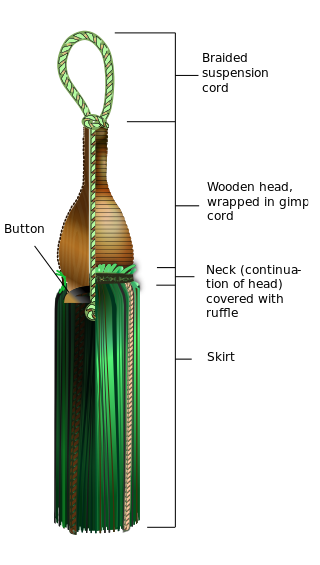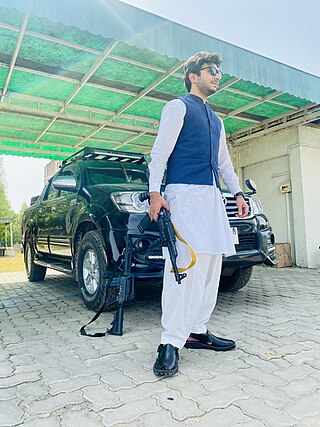
A tassel is a finishing feature in fabric and clothing decoration. It is a universal ornament that is seen in varying versions in many cultures around the globe.

The Punjabis, are an Indo-Aryan ethnolinguistic group associated with the Punjab region of South Asia, comprising areas of present-day eastern Pakistan and northwestern India. They share a common history, culture and language; generally speaking Standard Punjabi or various Punjabi dialects on both sides.

Giddha is a popular folk dance of women in the Punjab region. The dance is often considered derived from the ancient dance known as the ring dance and is just as energetic as bhangra; at the same time it manages to creatively display feminine grace, elegance and flexibility. It is a highly colourful dance form which has spread to all regions of India. Women perform this dance mainly at festive or social occasions. The dance is accompanied by rhythmic clapping, with a typical traditional folk song performed by elder women in the background.

Lohri is a popular winter Dogra and Punjabi folk festival celebrated primarily in Northern India. The significance and legends about the Lohri festival are many and these link the festival to the Duggar region and Punjab region. It is believed by many that the festival marks the passing of the winter solstice. Lohri marks the end of winter, and is a traditional welcome of longer days and the sun's journey to the Northern Hemisphere. It is observed the night before Maghi.

Phulkari refers to the folk embroidery of the Punjab region and Gulkari of Sindh in South Asia.

Sprang is an ancient method of constructing fabric that has a natural elasticity. Its appearance is similar to netting, but unlike netting, sprang is constructed entirely from warp threads. Archaeological evidence indicates that sprang predates knitting; the two needlework forms bear a visible resemblance and serve similar functions but require different production techniques.

Punjabi culture grew out of the settlements along the five rivers which served as an important route to the Near East as early as the ancient Indus Valley civilization, dating back to 3000 BCE. Agriculture has been the major economic feature of the Punjab and has therefore formed the foundation of Punjabi culture, with one's social status being determined by landownership. The Punjab emerged as an important agricultural region, especially following the Green Revolution during the mid-1960's to the mid-1970's, has been described as the "breadbasket of both India and Pakistan". Besides being known for agriculture and trade, the Punjab is also a region that over the centuries has experienced many foreign invasions and consequently has a long-standing history of warfare, as the Punjab is situated on the principal route of invasions through the northwestern frontier of the Indian subcontinent, which promoted to adopt a lifestyle that entailed engaging in warfare to protect the land. Warrior culture typically elevates the value of the community's honour (izzat), which is highly esteemed by Punjabis.

Punjabi dances are an array of folk and religious dances of the Punjabi people indigenous to the Punjab region, straddling the border of India and Pakistan. The style of Punjabi dances ranges from very high energy to slow and reserved, and there are specific styles for men and women.

The Armenian Taraz, also known as Armenian traditional clothing, reflects a rich cultural tradition. Wool and fur were utilized by the Armenians along with the cotton that was grown in the fertile valleys. During the Urartian period, silk imported from China was used by royalty. Later, the Armenians cultivated silkworms and produced their own silk.

Ghagra choli is a type of ethnic clothing for women from the Indian Subcontinent, notably in the Indian states of Rajasthan, Gujarat, Madhya Pradesh, Uttar Pradesh, Bihar, Haryana, Punjab, Himachal Pradesh, Uttarakhand, Jammu and Kashmir, as well as in the Pakistani provinces of Punjab and Sindh. In Punjab, the lehenga is traditionally worn with a kurti. It is a combination of the gagra or lehenga and the choli (blouse), however in contemporary and modern usage lehenga choli is the more popular and widely accepted term by fashion designers, trend setters, and boutiques in South Asia, since ghagra is synonymous with the half-slip (petticoat) worn as an undergarment below the sari.
Pakistani clothing refers to the ethnic clothing that is typically worn by people in the country of Pakistan and by Pakistanis. Pakistani clothes express the culture of Pakistan, the demographics of Pakistan, and cultures from Punjab, Sindh, Balochistan, Khyber Pakhtunkhwa, Gilgit-Baltistan, and Kashmir regions of the country. The clothing in each region and culture of Pakistan reflect weather conditions, way of living, the textiles and embroidery used and its distinctive style which gives it a unique identity among all cultures.

Punjabi festivals are various festive celebrations observed by Punjabis in Pakistan, India and the diaspora Punjabi community found worldwide. The Punjabis are a diverse group of people from different religious background that affects the festivals they observe. According to a 2007 estimate, the total population of Punjabi Muslims is about 90 million, with 97% of Punjabis who live in Pakistan following Islam, in contrast to the remaining 30 million Punjabi Sikhs and Punjabi Hindus who predominantly live in India.
Norigae is a typical, traditional Korean accessory used in Hanbok, which can be hung on goreum of a woman's jeogori or on her chima. The norigae functions as a decorative pendant and is both a good-luck charm hoped to bring something such as eternal youth, wealth or many sons, as well as a fashion accessory. Usually, the norigae from the parents' or in-laws' home was passed down to descendants.

Bhangra is a type of traditional folk dance of Punjab area of the Indian subcontinent. It is done in the season of harvesting. According to Manuel (2001), bhangra is especially associated with the vernal Vaisakhi festival, performed during harvest season between April and the first quarter of May.

The Punjabi ghagra is a four-piece outfit known as tewar or 'ti-or' which was traditionally worn by Punjabi women throughout the Punjab region with the outfit comprising a head scarf (Phulkari), kurta or kurti, ghagra and either a suthan or the Punjabi salwar (trousers). In modern times, the ghagra is worn by women in parts of Haryana, rural parts of south West Punjab, parts of Himachal Pradesh and during performances of Giddha in East Punjab.
Salwar or Shalwar is cloth worn from the waist to the ankles, covering both legs separately. It is the lower-garment of the Shalwar kameez suit which is widely-worn in South Asia. It is known for its lively hues, rich fabrics, and embroidery. It is also the national dress of Pakistan, and since the later 1960s with the salwar being used in government offices in Pakistan. The outfit has been a part of Punjabi tradition for centuries. Salwar can be distinguished from the Punjabi suthan which is shorter than the salwar.

Punjabi Kurta and Tamba are traditional costume for men of Punjab.

In the ancient Punjab region, people wore cotton clothing. Both men and women wore knee-length tops. A scarf was worn over the tops which would be draped over the left shoulder and under the right. A large sheet would be further draped over one shoulder which would hang loose towards the knees. Both male and female wore a dhoti around the waist. Modern Punjabi dress has retained this outfit but over its long history has added other forms of dress.

There are two types of Saraiki shalwar suits which originate in the southern area of Punjab, Pakistan. These are the Bahawalpuri shalwar suit and the Multani shalwar suit. The two main suits from that area.
Mohinder Kaur Bhamra is a British singer of Punjabi folk music, ghazals and Sikh hymns. Some of her songs have highlighted issues that concern British Indian women.
























